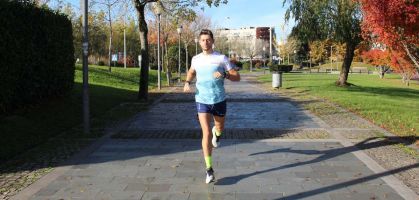By now I am sure that almost all of you know that to obtain a good performance when running, whether competing or simply training, it is not enough to plan only running sessions. It's necessary to implement and take into account certain elements that have direct involvement in improving fitness and, therefore, in the progress of our paces and marks. We are talking about aspects as relevant as rest, nutrition, running technique, mobility or strength.
This last aspect, strength training, is precisely one of the most important complements to continue wearing running shoes without any cessation of activity or stoppage, as it will be the best way to prevent injuries. But as we have told you many times, it is not only associated with a lower probability of injury, but it also improves performance, since a stronger musculature will be able to generate greater strength and, consequently, will allow us to run at a faster speed than we would without strength training.
Not sure which shoe to choose?
In a few simple steps we help you to choose the ideal running shoe for you.
GO TO THE RECOMMENDERStrength training will allow the body to demand less energy expenditure, so we will be able to last longer running at the same pace or we can run faster over the same distance.
Logically, strength training would not make sense without a good approach to the sessions within the training plan. Therefore, knowing how to combine running and gym work is essential to take advantage of the benefits of both types of training. Don't lose detail to what we are going to tell you next if you want to be a better runner through the effective combination of running and strength.
How can I combine my running and gym sessions?
Before we begin, we believe it is important to clarify that it is not essential to do strenth training in a gym, although it is very interesting due to the opportunity to use a greater number of resources in the form of machines, materials and a variety of weights. After making this clear, the first thing to do to combine both types of training effectively is to analyse the plan or programming, so that we can establish when and how much we will run and when and how much we will train strength.
Generally speaking, it is recommended that each day of the week that we train has a specific objective, whether it is running or in the gym. This means that each type of session should have a specific purpose, such as improving the aerobic base, accelerating recovery, improving fatigue resistance, increasing our VO2max, or improving our power, for example. That is why the ideal is to dedicate each day to a single type of session, that is, not to combine two types of session on the same day.
Knowing this, the next task is to place the gym training day between the running sessions. If we don't have too much experience in strength work, it is best to leave at least 48 hours between sessions, as it is better to perform them after a day of low-intensity or short training, because if we train strength after a demanding day of series or a long run it is possible that fatigue will harm us when performing the exercises and moving the weights.

If we already have more experience in the gym, we should also allow at least 24 to 48 hours of recovery between strength sessions. In this case its position within the mesocycle (training week) does not matter so much, although we should avoid doing a demanding strength training prior to a day of high intensity (series) or a competition.
Gym trainers
What if I want to do running and strength training on the same day?
We may find ourselves in the situation of having to combine a strength and running session on the same day. The can be many reasons for this. Because your training frequency is high and you need to include many sessions during the week without affecting rest days, because of lack of availability or time, to fit them better into the weekly schedule ...
This is where the concept of "interference" comes into play. Combining two types of sessions on the same day will have a certain impact on each other, reducing the improvements compared to if they were done separately
It is possible to minimise the effect of interference between sessions by leaving a margin between one session and the other, although it is difficult for an amateur runner to have the opportunity to train in the morning and in the afternoon on the same day. Ideally, there should be a margin of 6 to 8 hours between the running session and the gym session so that one does not negatively affect the other due to the neuromuscular fatigue generated.
But it is most common to have to perform the two sessions back to back. In this context, the first thing to analyse is what type of session we are going to prioritise on that particular day, that is, what is the main objective of that day of the week. Whichever it is, it is advisable to place the priority session in first place, with the complementary session taking place later. If the objective of the day is to improve strength levels, it will be better to do it before running. However, if we want to benefit, for example, from all the advantages of low-intensity running (increased plasma volume, increased mitochondrial and oxidative function, etc.), it will be better to do it before the gym.
What must be clear, whatever the order, is that it is not recommended to combine a medium- or high-intensity running session with strength training on the same day, as this would be very detrimental to the session performed in the second position.
The most advisable thing to do is to combine a low-intensity running session with the gym, so that the interference effect is reduced and both sessions can be carried out at the intensity and feeling of effort stipulated beforehand. However, even if you do them in the first place, try not to make the running sessions last more than an hour, taking it very easy and thinking about the strength training that will follow. The combined training day should not condition the rest of the weekly sessions!
Read more news about: Running Training






























